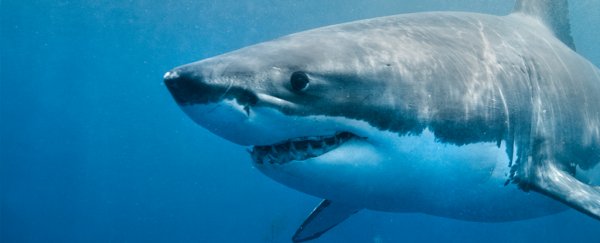A 1,000-pound (453 kilograms) migrating great white shark surfaced off the coast of New Jersey April 28 while seeking rich fishing grounds farther north.
Researchers nicknamed the shark 'Ironbound' when he was first caught and tagged in 2019, as he was found near West Ironbound Island near Lunenburg, Nova Scotia. The 12.4-foot-long (3.7 meters) shark migrating when he showed up on satellite.
"Mating season is over, we think, and Ironbound is on his way north to get into some good feeding ground and bulk up again for the next year," Bob Hueter, chief scientist at the nonprofit Ocearch, told CNN about the find.
Ocearch tags and tracks great white sharks (Carcharodon carcharias) in a bid to better understand their elusive migrations. A harmless device, called a SPOT tag, is attached to the dorsal fin and relays the shark's location to a global positioning device (GPS) satellite. The tag is designed to fall off after a few years.
 Ironbound tagged by the nonprofit Ocearch in 2019. (Ocearch)
Ironbound tagged by the nonprofit Ocearch in 2019. (Ocearch)
The trackers have a bit of an error margin, meaning that the shark's precise location might be off by quite a few feet or meters when they surface within range of a GPS satellite.
"That error bar can be the difference between one side of Long Island and the other," George Burgess, a marine biologist and director emeritus of the Florida Program for Shark Research at the Florida Museum of Natural History, told Live Science in 2019.
Hueter told CNN that Ocearch has tagged great white sharks as long as 17.5 feet (5 m) and as heavy as 4,000 pounds (1,814 kg), meaning Ironbound is of modest size.
Ironbound has traveled an estimated 13,000 miles (20,921 kilometers) since he was first tagged. Most recently, he was spotted May 3, according to Ocearch data, when the adult male was much farther out in the Atlantic Ocean, due east of Philadelphia.
Great whites are famous among the public due to their appearance in movies such as 'Jaws' (1975) and 'Sharknado' (2013), along with those franchise's sequels. That said, their behavior is nowhere near how the movies portray them.
"White sharks are often portrayed as 'mindless killers' and 'fond of human flesh." However, this does not seem to be the case; we just look like their food," Laura Ryan, a postdoctoral researcher at Macquarie University in Australia, previously told Live Science.
They migrate for food and breeding, and researchers have recorded them in temperate and tropical oceans around the world; they often appear off the coasts of countries such as the US, Australia and South Africa.
Great white sharks are vulnerable to extinction and have a decreasing population, according to a 2018 assessment by the International Union for Conservation of Nature (IUCN). While the sharks are not technically endangered, they are at risk of acquiring that status due to human threats such as overfishing.
Related content:
This article was originally published by Live Science. Read the original article here.
